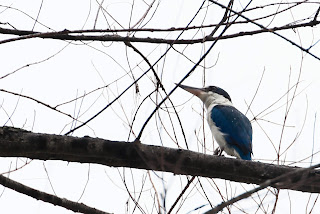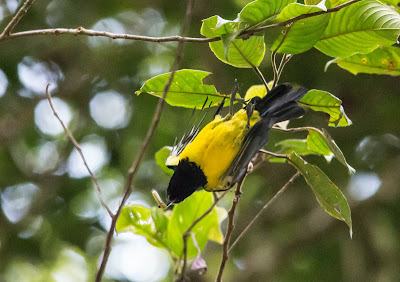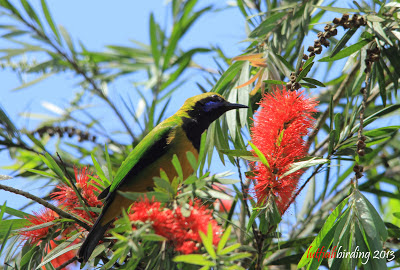Happy new year to all birders out there. May 2013 bring you a lot of sightings with new species especially the rare ones. It is a great relief that the doomsday prophecy that the world was going to end on 21 December 2012 was proven to be wrong. I am glad to still be alive to enjoy this life and my passion for birding for a few more years. At least my thousands of ringgit in investment for the equipments has not gone to waste.
Some of you would have come out with a list of resolutions for 2013 even before the the last minutes of 2012 come to an end, i on the other hand come up with one after the fireworks started..he he so last minute. My target for 2013 is to record more species to complete my first 100 list and to take sharper shots of the birds i come across.
For the first goal i have to make more birding trips to places i have never been before which is easier said than done. This is because i will be awfully busy with work for 2013 with a few projects lining up to be kicked started. But with March coming up soon where the migration of some species starting to come down this way i might have some chance of adding a few more species to achieve my goal.
For the second goal of getting sharper photos i have just invested in a good tripod and a gimbal head to support my long telephotos zoom lens. All this while i have taken most of my bird photos handheld as i rarely stayed in one spot for long. Taking photos this way is easier as i do not need to carry my tripod wherever i go but it requires a very steady hand to get sharp photos. Unless if i have a very good fast lens that can give me high shutter speed at low ISO in low light to freeze motion which can reduce blur, but these lenses with 500 or 600mm focal length, IS and f4 are very very expensive!!
I noticed a lot of pro birders used good support systems to get fantastically sharp photos. They used sturdy tripods and gimbal heads like the Wimberley WD-200 to get strong support with fluid motion of their camera to follow the birds movements even in flight. So i thought i would give it a try to shoot using a very good sturdy tripod and a gimbal head to support my 5DMK3 plus either the Canon 400mm f5.6 non-IS lens or Sigma 150-500mm f5-6.3 OS HSM zoom lens.
I have done some research on tripods reviewed by various parties on the internet and i have narrowed down to the Benro A-297EX, Vanguard Alta Pro 263 AB100 or Manfrotto 055XPROB Pro tripods. All of these three are excellent tripods with the Vanguard have better reviews, and having won awards for best product i was keen to get it eventhough it is the most expensive among the three. However, after inspecting the Vanguard at the shop i was disappointed with the sturdiness, its legs are not that strong and easily shaken. It is a versatile tripod with the central column can be adjusted to various angles for macro shots just like the Benro and Manfrotto. However, my main criteria is the tripod must be solid,sturdy, can support a minimum of 7kg of combined camera, lens and flash weight, aluminum, not more than three section and can be extended to almost my height at around 1.8m so i do not have to bend when i shoot bird photos.
The Benro A-297EX is quite affordable and come with the right specifications and versatility however i could not get my hands on a copy for testing as some shops do not carry it and i have to wait for three months for the new production stock to arrive. So, i checked the Manfrotto 055XPROB Pro out and i was impressed. At the full legs extension it managed to support me leaning on it with minor flexing, solid as a rock! It is made of aluminum with three legs section with flip locks, versatile central columns at four angles for macro shots, can support up to 7 kg and can be extended to as tall as i am, and it even comes with a carrying bag, and it only cost me RM450, perfect! The only downside is it weighs quite a bit due to the quality of construction. Here are some photos below of the Manfrotto tripods:
with central column extended:
with central column adjusted:


Of course a tripod alone is useless without a head to hold the camera. I thought about using a ball head but they are not as fluid as gimbal heads especially when i have to follow a bird in flight to have the focus lock onto the bird, that is why a lot of pro birders use them. The only problem with them is that they are very expensive here in Malaysia. I looked at gimbal heads by Jobu, Photo Clam and Wimberley which are all very good but very costly , until i came across the one produced by Manfrotto which fit my budget - Manfrotto 393 Heavy Duty gimbal head lens support which cost me only RM470(USD150). This gimbal head is less sexy than the ones produced by the three manufacturers mentioned earlier but it is solid and can do the job well. It comes with a 4 inch quick release plate, made of 6mm thick solid aluminum and weighs 1.60 kg. Basically it is made of two U-sections with hinges and a rotating base which is connected to the tripod base. It can support quite a heavy load based on the solidness of its construction. I can place my camera either hung from the top or at the bottom like a swing, either way it works fine. The movement is quite smooth with the camera remains at any position firmly if you balance it right from the beginning. The photos below explain better:

Manfrotto 393 Heavy Duty Gimbal Head
Manfrotto 393 Gimbal Head on Manfrotto 055X PROB Pro tripod
The support system with Canon 5DMK3 plus Sigma 150-500mm f5-6.3 OS HSM lens
I am feeling good with the system that i bought and hopefully it can help improve the image quality of my shots. I know i need some practice and patience taking photos using a tripod as taking photos of fast moving birds is not easy. I will have to stay at one spot a lot longer and play a waiting game. I need to study their behavior and recce at spots they like to perch more so i can pre-focus on those spots to have more chance of success. Anyway a journey to success begins with a first step. It is time for me to start my birding in this new year 2013, wish me lots of luck.




















































